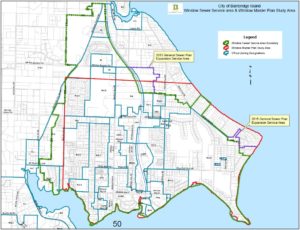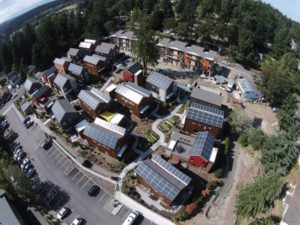Inspired by an innovative housing program in Kirkland, WA, in 2009 the City of Bainbridge Island adopted the Housing Design Demonstration Program (HDDP) to encourage affordable housing, a vibrant pedestrian oriented-downtown, and innovative green building design. The program offers a 1.5x density bonus to green-certified affordable housing projects. To-date more than 250 new homes have been green building certified, including the solar-powered Grow Community.
- Category
- Land Use and Development
- Subcategory
- Density / FAR Bonus
- Adopted By
- City of Bainbridge Island, WA
- Applies To
- Winslow Master Plan Area
- Owned By
- City Council of Bainbridge Island
- Managed By
- City of Bainbridge Island
- Participation
- Public Hearing Sept. 2016
- Year of Adoption
- 2009
- Current Version
- 2016
- Update Cycle
- ~ 3 years
- Recent Action
- 2016 Renewed for an additional year
- Code/Policy
- 2016 Housing Design Demonstration Project Program
- Pursuant to
- Bainbridge Island Municipal Code, Land Use Provisions
- Referenced
- State Environmental Policy Act Chapter 43.21C RCW
Bainbridge Island, Washington is a small surburban community on the west side of Puget Sound, 35 minutes by ferry from Seattle to the main town center known as Winslow. In 2015, the Island’s population of 23,390 was predominantly white, well-educated, and relatively affluent. Housing stock is 80% detached single-family homes in a very low-density land use pattern that occupies about 90% of the Island’s land area, with an average single-family home price just under $700,000. The commercial town center in Winslow contains most of the services, but contains very little residential component.
The city’s 2004 Comprehensive Plan had a goal to “encourage the availability of affordable housing to all economic segments [and] promote a variety of densities and, housing types” within the Winslow Master Plan area. The Housing Design Demonstration Program (HDDP) was a strategy to do just that, proposed by active citizens and was passed by the Bainbridge City Council in 2009.
The purpose of the HDDP (Subsection 20.Q of Bainbridge Island Code Section 2.16 Land Use Procedures) is to encourage projects that increase the variety of affordable housing choices available to underserved residents, and to promote smaller homes, low-impact development, and innovative “green” building practices, through a limited number of demonstration projects.
| Policy Title | Purpose of Policy |
|---|---|
| Housing Density Demonstration Project BIMC Section 2.16.020.Q(scroll down to subsection Q) | To encourage projects that increase the variety of affordable housing choices available to underserved residents, and to promote smaller homes, low-impact development, and innovative “green” building practices. |
The following projects have or are being built through the Bainbridge Island Housing Design Demonstration Project:
- Ferncliff Village– 48 single family homes and condos, community land trust model
- Madison Park, 13-unit single family residential subdivision.
- Grow Community, 142 single family, condos and multi-family apartment development (see Case Study: Grow Community)
- New Brooklyn Glen (Suzuki Property) – 75 home mixed income development
The HDDP program is the only part of city code to require green building, but the program has resulted in the certification of more than 250 homes under LEED or Built Green that would not have been built green otherwise.
Inspired by an innovative housing program in Kirkland, The HDDP program and incentive was developed through more than a year of meetings with the Planning Commission, energized by the advocacy of Housing Resources Bainbridge, a local affordable housing advocacy group, working closely with Councilmember Hilary Franz (now State Commissioner of Public Lands). They initially considered including neighborhood service centers in a larger geographic area, but decided it would only apply in the greater Winslow area.
There was some concern within the community about the impact of increased density that could change the character of the historic town, and the potential to “drain the aquifer” on an island where water supply is a primary concern. Advocates countered arguing that the small number of projects authorized would limit the impact on the town center’s character, and low-impact, green building techniques would ensure the denser projects would have lower water demands than projects developed under non-incentivized zoning code.
After being drafted and reviewed by the Planning Commission in 2008, it went through City Council’s Land Use Subcommittee, and was passed by the full Council in November 2009 with a 3 year window. After 3 years, a few projects pursuing the incentive were in plan review stage, but had not started construction yet, so the Council extended an additional year through 2013. Again in 2013, the Council studied the ordinance, made a few changes then adopted revised ordinance for another 3 years through the end of 2016. In 2016 the ordinance was revised and renewed for another year while the Council completes its comprehensive planning process.

The HDDP is applicable to all properties located within the Winslow study area of the Winslow master plan and the Winslow sanitary sewer system service area. An application for a housing design demonstration project can be applied to single-family residential subdivisions, mixed-use/multifamily and multifamily developments.
To meet HDDP requirements, units are limited to 1600 square feet or less, must provide a variety of unit types and sizes and must include innovative building design elements to achieve 20-30% reduction of water use and 25%-35% reduction of energy use, and must provide proof of certification to Built Green Level 4, LEED Silver or Evergreen Sustainable Development Standard.
Qualifying projects receive a variety of development incentives, depending on which of four tiers the project qualifies for. All HDDP projects are eligible for modifications to development standards, including zero-lot line subdivisions, reduced lot size, setbacks, and parking requirements, increased lot coverage, and relaxed open space requirements. In addition to these development standard incentives, projects qualifying as Tier 2, 3, or 4 receive density incentives allowing them to build more units per acre than allowed for standard projects, ranging 1.5x to 2.5x of base density allowed depending on the tier.
The adoption of the revised 2013 ordinance raised the bar making it more difficult to qualify, for example by requiring 10% affordable housing units for Tier 2 projects, where before affordable housing requirements only applied to Tier 3 and 4 projects.
HDDP projects are reviewed in the same manner as other similar applications, with additional review including a conceptual phase review, a requirement for public participation followed by a pre-application conference that responds to public input. Once it’s determined that the project will qualify, a land use permit application is submitted and reviewed by staff, and the permit is approved or denied based on underlying zoning requirements and additional criteria outlined in the HDDP section of the municipal code.
To qualify for the incentive, each project is evaluated for innovation and achievement of the goals of HDDP specified in BIMC 2.16.020.Q based on 3 categories of factors: Housing Diversity, Innovative Site Development, and Innovative Building Design. To be approved, the project must meet various requirements under each factor (or explain why it is inappropriate or can’t be met), and also:
- Demonstrate how development standard modifications (parking, setbacks etc – above) are needed to achieve HDDP goals and innovative designs;
- Propose a design that is harmonious with the property and surrounding neighborhood
- Not adversely impact public services to surrounding properties
- Comply with other city codes (except where modified under HDDP)
- And if developed in phases, each phase must comply with requirements on its own
A point system is applied to determine how each project meets the requirements for the Tier and the associated incentives the project is applying for.
| Related Case Study: Density Bonus for Solar-Powered Grow Community, Bainbridge, WA | Kirkland, WA’s Innovative Housing Demonstration Program, which inspired HDDP. Memo to Houghton Community Council Nov. 28, 2006 |
| Bainbridge Island – City Webpage on the program | Article: “City Council passes HDDP” Wed Aug 19th, 2009 by Bainbridge Island Review |
Housing diversity goals and evaluation criteria say the project must include a diversity of types (e.g. single family, townhomes, apartments, live/work, etc) and sizes (800 – 1,600 square feet) that provide for a broad range of income and family sizes. All units must be less than 1,600 sq. ft. 10% of housing units are required to be affordable housing units for Tier 2 projects (gives 1.5x base density incentive), and 50% must be affordable housing units for Tier 3 and 4 projects (gives 2.5x base density incentive), and they must remain affordable for 50 years.
Innovative Site Development is evaluated using a point system ranging from 16 points for Tier 1 up to 36 points for Tier 4. Points are earned by incorporating the following site development features and best practices: Low-impact development for on-site stormwater infiltration and treatment (e.g. rain gardens, and biorentention); porous / pervious hardscapes for parking and pedestrian areas; drought tolerant landscaping, shared open space; composting facilities; and incorporating biodiversity. Other features include pedestrian/bike friendly transportation, electric vehicle charging and transit-oriented development.
Innovative Building Design is evaluated based on the project pursuing green building certification with higher levels of certification required the greater density bonus being sought, ranging from LEED certification or Built Green 4 star at Tier 1, up to Passive House or Living Building Challenge certification at Tier 4. At the highest Tier 3 & 4 levels, lower certification can be exchanged for more affordable housing units (Tier 3) or less affordable housing and higher green certification. All projects are required to include innovative building design to achieve 20-30% water use reduction and 25-35% improved energy efficiency, and to incorporate renewable energy, beyond-code efficiency, water efficient fixtures, water reuse, green materials inside and out, and accessibility.
Developers may be daunted by the complex approval process and requirements of this program, however the City provides dedicated staff support and consultation to assist in the process. Heather Wright, who has managed this program since it was introduced, reflects “while I am in favor of this incentive, it should be noted that the review process is quite a bit more complex. It would be wonderful if we could fast-track these types of projects, but the shear amount of code criteria make that virtually impossible.”
After initially offering the incentive to projects pursuing either innovative green building design OR affordable housing, in 2013 it was updated to require affordable housing units for all four tiers. Wright prefers this approach because “this region is really struggling to provide affordable housing. What’s interesting to me is the unit size cap was a reaction to seeing McMansions being built at an unprecedented rate. Now we are seeing a backlash for tiny houses. To tie it back to affordability; I think we could provide an even greater density bonus for the development of tiny houses.”
In 2016, the City Council passed another 1-year extension of the HDDP to allow for the completion of the City’s Comprehensive plan update. The biggest change in this version updates the policy to reflect new statewide requirements for low-impact development, which previously earned innovative site design points under HDDP. This bill institutes a new Water Quality and Conservation section that requires an integrated approach to reducing water use and improving the quality of stormwater runoff through the use of greywater, rainwater harvesting, green roofs and covered parking among other strategies.
